1. The Importance of Conversion Premium in Driving Profitability
1. Understanding Conversion Premium: The Foundation of Profitability
Conversion premium refers to the additional value that a customer is willing to pay for a particular product or service compared to alternative options available in the market. It is a crucial metric that can significantly impact a company's profitability. By understanding the concept of conversion premium, businesses can effectively position themselves to drive higher revenue and gain a competitive edge in their industry.
2. The Role of Branding in Driving Conversion Premium
One of the key factors that influence conversion premium is branding. A strong brand creates trust and loyalty among customers, making them more willing to pay a premium for the company's offerings. For example, consider the tech giant Apple. Despite the availability of several alternative smartphones in the market, Apple's loyal customer base is willing to pay a higher price for their products due to the brand's reputation for quality, innovation, and reliability.
3. Quality as a Driver of Conversion Premium
Another important aspect that drives conversion premium is the quality of a product or service. Customers are often willing to pay more for superior quality, as it ensures better performance, durability, and overall satisfaction. For instance, luxury car manufacturers like Mercedes-Benz or BMW command higher prices compared to their competitors because of their reputation for exceptional craftsmanship, advanced features, and a superior driving experience.
4. Differentiating through Unique Features and Innovation
Companies can also drive conversion premium by offering unique features or innovations that provide a distinct advantage over their competitors. These differentiators create a perception of value in the minds of customers, making them willing to pay more for the product or service. Consider the case of Tesla, which revolutionized the electric vehicle market with its cutting-edge technology, long-range capabilities, and autonomous driving features, allowing the company to command a higher price and generate significant conversion premium.
5. Superior Customer Experience: A Catalyst for Conversion Premium
Providing exceptional customer experience is a crucial driver of conversion premium. When businesses go above and beyond to meet and exceed customer expectations, customers are more likely to be willing to pay a premium for their offerings. For example, luxury hotels like The Ritz-Carlton or Four Seasons differentiate themselves by delivering personalized and memorable experiences, which justifies the premium prices they charge compared to other hotel chains.
6. Pricing Strategy: Balancing Conversion Premium and Market Competitiveness
While conversion premium is essential for driving profitability, it is crucial to strike a balance between the premium and market competitiveness. Setting prices too high can lead to a loss of customers to more affordable alternatives, while setting prices too low may erode potential profitability. Therefore, businesses need to carefully assess market dynamics, competitor pricing, and customer preferences to determine the optimal pricing strategy that maximizes conversion premium without sacrificing market share.
7. leveraging Data and analytics to Optimize Conversion Premium
To effectively drive conversion premium, businesses must leverage data and analytics to gain insights into customer behavior, preferences, and pricing sensitivity. By analyzing customer data and conducting market research, companies can identify opportunities to enhance their offerings, tailor pricing strategies, and optimize conversion premium. For instance, e-commerce giant Amazon utilizes sophisticated algorithms and customer data analysis to personalize product recommendations and pricing, thereby maximizing conversion premium.
Conversion premium plays a pivotal role in driving profitability for businesses. By focusing on branding, quality, unique features, superior customer experience, and strategic pricing, companies can effectively unlock the potential of conversion premium. By understanding and leveraging the factors that drive conversion premium, businesses can differentiate themselves, attract loyal customers, and ultimately enhance their bottom line.
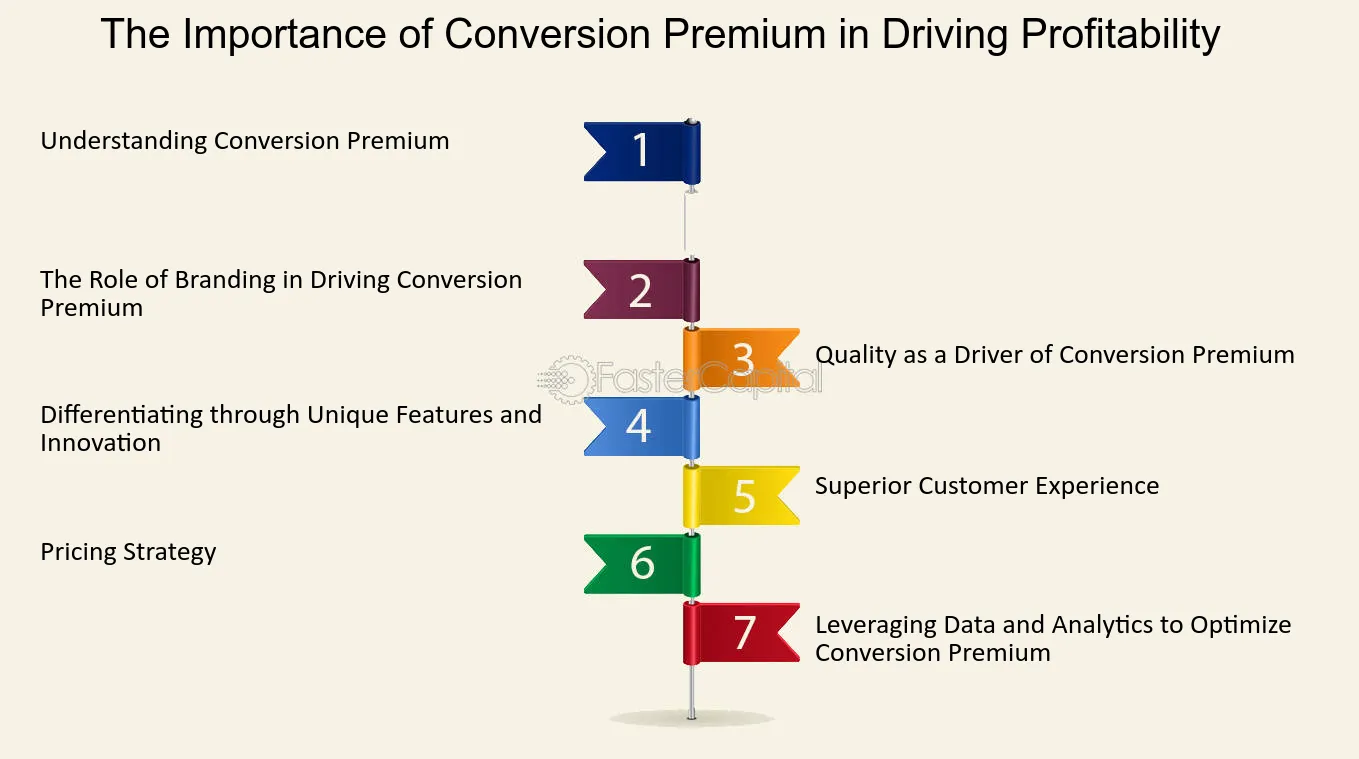
The Importance of Conversion Premium in Driving Profitability - Conversion Premium: The Key to Unlocking Profitability
2. Understanding the Importance of Conversion Premium and Competitive Analysis
1. Understanding Conversion Premium and its Significance
Conversion premium refers to the additional value that a business can extract from its customers by persuading them to switch from a competitor's product or service. This concept is crucial for businesses seeking to gain a competitive edge in the market. By understanding conversion premium, companies can devise effective strategies to entice customers away from their competitors and boost their own market share.
From the customer's perspective, conversion premium represents the added value they perceive in switching to a new product or service. This value can come in various forms, such as better features, superior quality, enhanced customer service, or even a lower price. Customers are naturally inclined to stick with what they know, so convincing them to switch requires a compelling proposition that clearly demonstrates the benefits they will gain.
2. The Importance of Competitive Analysis
Competitive analysis plays a pivotal role in understanding the conversion premium within a specific market. By thoroughly analyzing competitors, businesses can identify their unique selling points, weaknesses, and areas where they can outshine them. This analysis helps companies understand the conversion premium offered by their rivals and enables them to devise strategies to surpass it.
To illustrate the importance of competitive analysis, let's consider a hypothetical scenario in the smartphone industry. Company A, a market leader, is renowned for its cutting-edge technology and sleek design. Company B, a newcomer, wants to penetrate the market and lure customers away from Company A. By conducting a comprehensive competitive analysis, Company B can identify the conversion premium offered by Company A and determine the gaps in their own product or service. Armed with this knowledge, Company B can then focus on developing features that exceed the conversion premium of Company A, such as longer battery life or a more user-friendly interface.
3. strategies to Enhance conversion Premium
To maximize conversion premium, businesses need to implement effective strategies that not only attract customers but also convince them to switch from their competitors. Here are some strategies to consider:
A) Highlight Unique Selling Points: Clearly communicate the unique features, benefits, or advantages that set your product or service apart from the competition. This will help customers understand the added value they will gain by making the switch.
B) Offer Incentives: Provide incentives to entice customers to switch, such as discounts, exclusive offers, or loyalty programs. These incentives can tip the scale in your favor and make the decision to switch more appealing.
C) enhance Customer experience: Invest in delivering exceptional customer service and support. By providing a seamless and personalized experience, you can create a positive impression that encourages customers to switch.
D) Leverage Social Proof: Showcase positive testimonials, reviews, or case studies from satisfied customers who have already made the switch. This social proof can instill confidence in potential customers and further enhance the conversion premium.
4. The Best Option: A Comprehensive Approach
While each of the strategies mentioned above can contribute to enhancing conversion premium, the best approach is to adopt a comprehensive strategy that combines multiple tactics. This comprehensive approach ensures that businesses cover all bases and leave no stone unturned in their quest to gain the competitive edge.
For instance, a business aiming to surpass its competitor's conversion premium could highlight its unique selling points, offer incentives for switching, provide exceptional customer experience, and leverage social proof. By combining these strategies, the business creates a compelling proposition that not only attracts customers but also convinces them to switch.
Understanding conversion premium and conducting thorough competitive analysis are essential steps for businesses aiming to gain a competitive edge. By implementing effective strategies and adopting a comprehensive approach, companies can entice customers away from competitors and increase their market share.
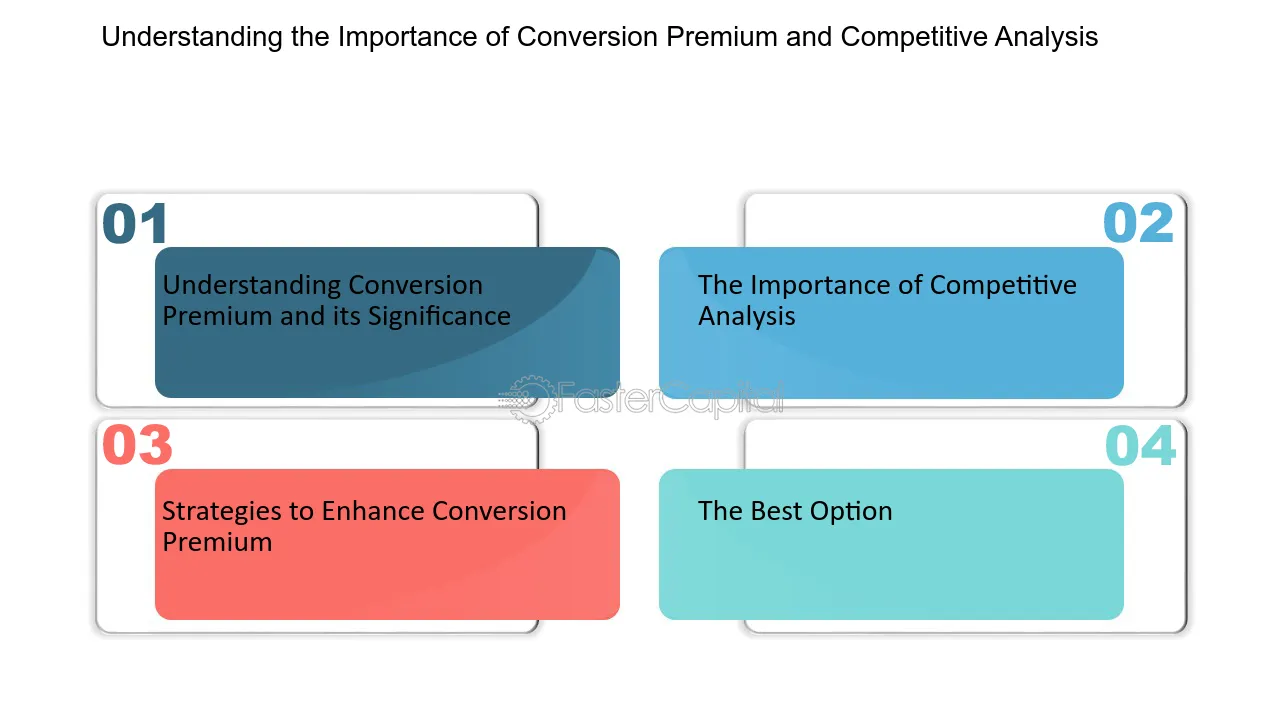
Understanding the Importance of Conversion Premium and Competitive Analysis - Conversion Premium and Competitive Analysis: Gaining the Edge
3. Understanding the Importance of Conversion Premium
Understanding the Importance of Conversion Premium
When it comes to content marketing, one of the key goals is to create compelling offers that drive conversions. But what exactly is "conversion premium" and why is it important? In simple terms, conversion premium refers to the added value or incentive that encourages a visitor to take action and convert into a lead or customer. It is the extra push that tips the scales in your favor and makes your offer irresistible. Understanding the importance of conversion premium can make a significant difference in your content marketing efforts, so let's delve deeper into this concept.
From the perspective of the audience, conversion premium plays a crucial role in their decision-making process. With countless options available online, consumers are constantly bombarded with offers and advertisements. To stand out from the crowd, you need to offer something unique and valuable. Conversion premium can be the differentiating factor that convinces a potential customer to choose your offer over your competitors'. For example, let's say you are selling an online course on photography. Offering a bonus module with exclusive tips from a renowned photographer can be the conversion premium that entices customers to choose your course over others.
From a business standpoint, conversion premium is equally important. It helps increase conversion rates and ultimately boosts your bottom line. By providing an added benefit or incentive, you can create a sense of urgency and motivate visitors to take action immediately. This could be in the form of limited-time offers, exclusive discounts, or free bonuses. For instance, a clothing brand could offer a free accessory with every purchase, encouraging customers to complete their order right away to take advantage of the bonus item.
Now that we understand the significance of conversion premium, let's explore some effective strategies to implement it in your content marketing:
1. offer exclusive discounts or promotions: Providing discounts or promotions that are only available to a select group of customers can create a sense of exclusivity and encourage immediate action. For example
4. Understanding the Importance of Conversion Premium and Customer Retention
Understanding the Importance of conversion Premium and customer Retention
In today's competitive business landscape, acquiring new customers is undoubtedly important. However, retaining existing customers and building their loyalty is equally crucial, if not more so. This is where the concepts of conversion premium and customer retention come into play. Conversion premium refers to the additional value that a customer brings to a business over their lifetime, while customer retention focuses on strategies and efforts aimed at keeping customers engaged and loyal. In this section, we will delve into the significance of conversion premium and customer retention, exploring different perspectives and providing in-depth insights.
1. The Value of Conversion Premium:
Conversion premium is the extra value that customers generate beyond their initial purchase. It encompasses repeat purchases, increased average order value, upsells, cross-sells, referrals, and brand advocacy. By understanding and maximizing conversion premium, businesses can significantly boost their revenue and profitability. For example, a study by Bain & Company revealed that increasing customer retention rates by just 5% can lead to a 25-95% increase in profits. This highlights the immense value of conversion premium in driving long-term business success.
Customer retention is the key to building long-lasting relationships with customers and fostering their loyalty. Loyal customers are more likely to make repeat purchases, refer others to the business, and provide valuable feedback. To achieve customer loyalty, businesses must focus on delivering exceptional customer experiences, personalized interactions, and consistent value. For instance, Amazon Prime exemplifies effective customer retention strategies by offering benefits like free shipping, exclusive deals, and access to streaming services. This comprehensive approach keeps customers engaged and incentivizes them to remain loyal.
3. Strategies for Enhancing Conversion Premium and Customer Retention:
To maximize conversion premium and customer retention, businesses can employ various strategies. These include:
A) Personalization: Tailoring products, services, and marketing messages to individual customer preferences enhances their overall experience and encourages repeat purchases.
B) Customer Support: Providing prompt, reliable, and empathetic customer support helps build trust and loyalty. Utilizing chatbots, self-service options, and dedicated support teams can streamline the process.
C) Loyalty Programs: Implementing loyalty programs with rewards, discounts, and exclusive perks incentivizes customers to stay engaged and loyal. Starbucks' loyalty program, for instance, offers free drinks, birthday rewards, and personalized offers to keep customers coming back.
D) Customer Feedback: Actively seeking and acting upon customer feedback demonstrates a commitment to continuous improvement and customer satisfaction. Feedback loops can be established through surveys, social media listening, and customer reviews.
4. The Best Approach: Combining Conversion Premium and Customer Retention:
While both conversion premium and customer retention are important individually, the best approach is to combine them synergistically. By focusing on customer retention and delivering exceptional experiences, businesses can increase conversion premium and drive long-term value. For example, Apple's ecosystem of products and services, including iPhones, MacBooks, and Apple Music, not only encourages customers to remain loyal but also generates additional revenue through cross-selling and upselling.
Understanding the importance of conversion premium and customer retention is vital for businesses looking to build loyalty in today's competitive market. By leveraging strategies that enhance conversion premium and prioritize customer retention, businesses can not only boost their revenue but also foster long-term relationships with their customers.
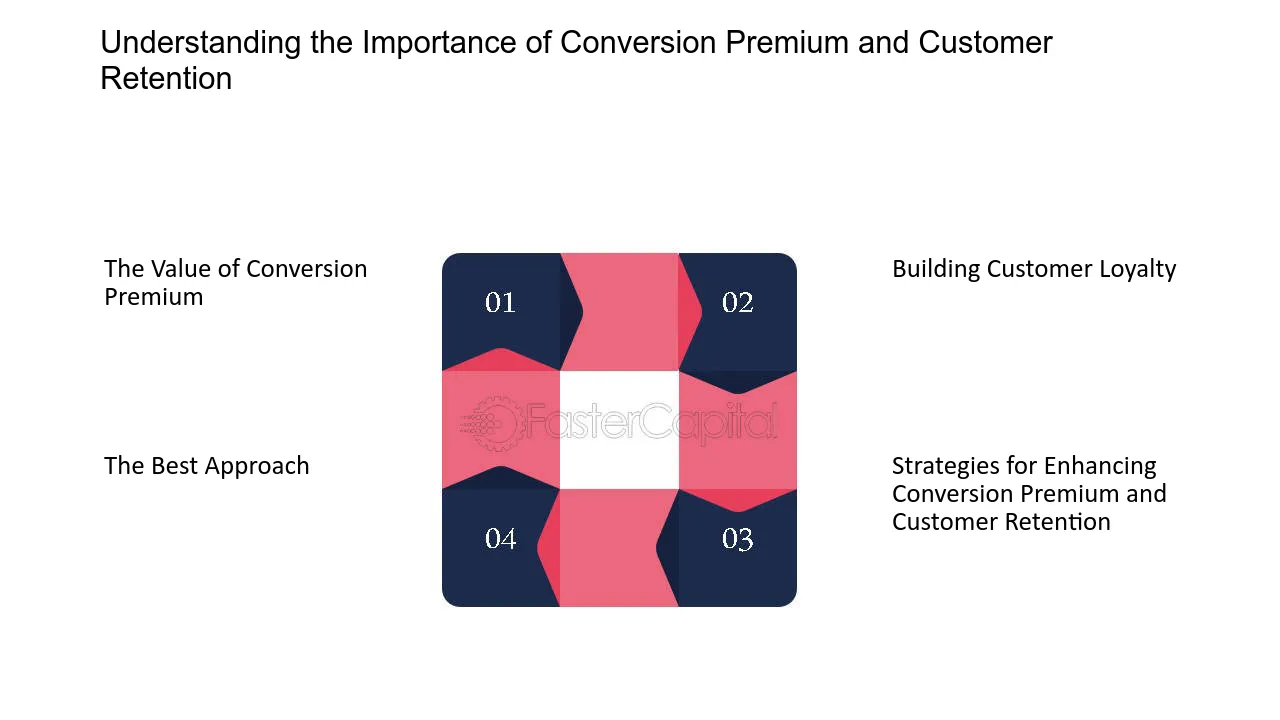
Understanding the Importance of Conversion Premium and Customer Retention - Conversion Premium and Customer Retention: Building Loyalty
5. Understanding the Importance of Conversion Premium
Understanding the Importance of Conversion Premium
When it comes to optimizing landing page design, one crucial factor that often gets overlooked is the concept of conversion premium. Conversion premium refers to the additional value that a visitor brings when they convert on your website. It goes beyond just the immediate transaction and encompasses the potential for future sales, referrals, and brand loyalty. Understanding the importance of conversion premium is essential for businesses looking to maximize their return on investment (ROI) and build long-term customer relationships.
1. Increased Lifetime Value: One of the primary reasons why conversion premium is important is because it directly impacts the lifetime value of a customer. When a visitor converts on your website, they become a customer and have the potential to make repeat purchases over time. By focusing on optimizing your landing page design to maximize conversions, you increase the likelihood of turning visitors into long-term, high-value customers.
For example, let's consider an e-commerce website selling fitness equipment. A visitor who converts by purchasing a treadmill not only generates immediate revenue but also has the potential to buy other fitness-related products in the future, such as weights, exercise mats, or resistance bands. By understanding the conversion premium associated with each customer, the website can tailor its marketing efforts and nurture the customer to increase their lifetime value.
2. word-of-Mouth marketing: Another aspect of conversion premium is the potential for word-of-mouth marketing. When someone has a positive experience with your brand and converts on your website, they are more likely to share their experience with others. Positive word-of-mouth can significantly impact your brand's reputation and attract new customers without any additional marketing efforts or expenses.
For instance, imagine a software company that offers a free trial of their product. When a visitor converts by signing up for the trial and has a great experience using the software, they may recommend it to their colleagues or friends in the industry. This organic referral can lead to new customers who have a higher likelihood of converting and becoming long-term users themselves.
3. customer Loyalty and advocacy: Conversion premium also plays a vital role in fostering customer loyalty and advocacy. When a visitor converts and has a positive experience with your brand, they are more likely to become repeat customers and advocates for your products or services. These loyal customers not only continue to generate revenue but also act as brand ambassadors, promoting your business to their networks.
Consider a subscription-based meal delivery service. When a visitor converts and starts receiving their meals, they become accustomed to the convenience and quality of the service. Satisfied customers are more likely to continue their subscription, refer friends and family, and leave positive reviews online. By recognizing the conversion premium associated with these loyal customers, the company can focus on building strong relationships and providing exceptional customer service, ensuring long-term success.
Understanding the importance of conversion premium is crucial for businesses to optimize their landing page design and maximize their ROI. By recognizing the potential for increased lifetime value, word-of-mouth marketing, and customer loyalty, companies can make informed decisions about their marketing strategies and prioritize efforts that drive conversions. By continuously analyzing and optimizing landing page design to enhance conversion rates, businesses can unlock the full potential of conversion premium and build sustainable growth.
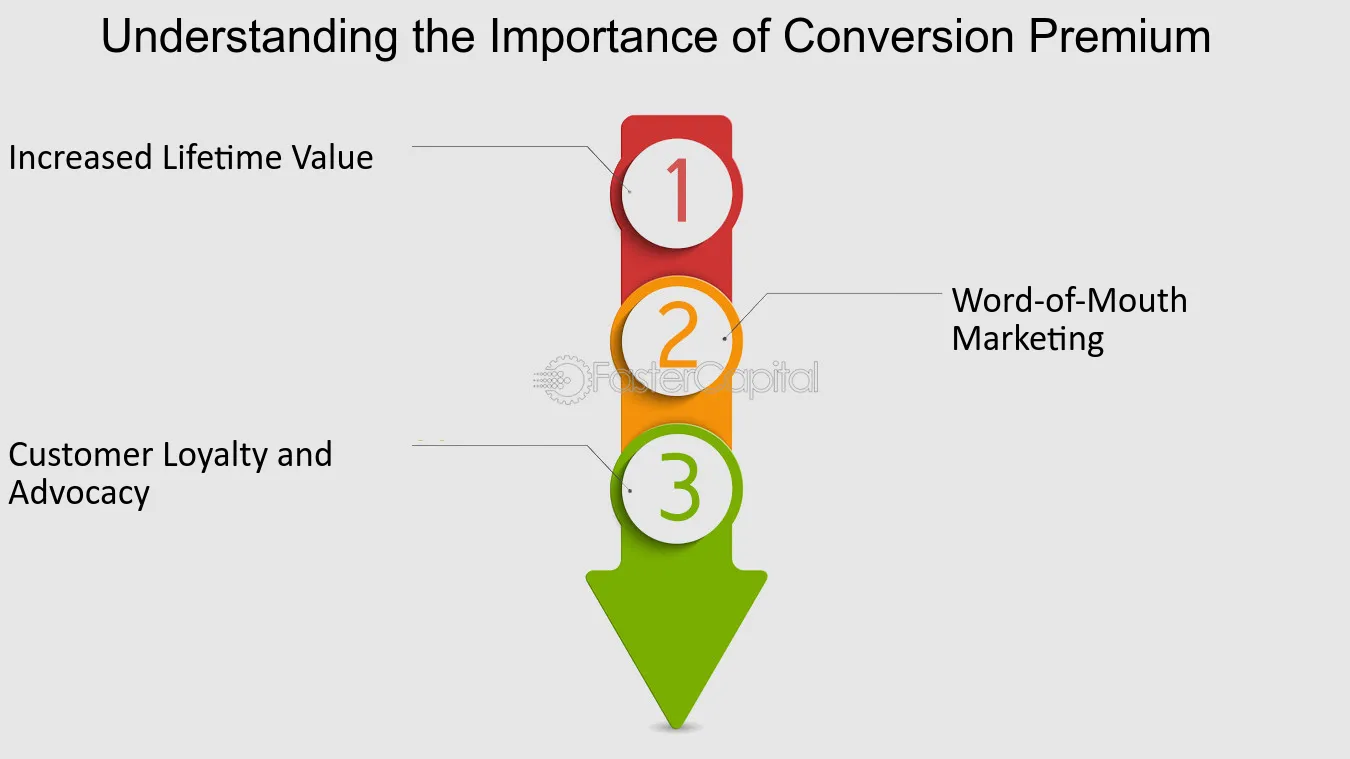
Understanding the Importance of Conversion Premium - Conversion Premium and Landing Page Design: Best Practices
6. Understanding the Importance of Conversion Premium and Personalization
Understanding the Importance of Conversion Premium and Personalization
In today's digital landscape, businesses are constantly looking for ways to engage and convert their online visitors into loyal customers. One of the most effective strategies to achieve this is through the implementation of conversion premium and personalization techniques. Conversion premium refers to the extra value or benefit that a customer receives when they convert, such as a discount, free shipping, or exclusive content. On the other hand, personalization involves tailoring the customer experience based on their preferences, behavior, and demographic information. Both conversion premium and personalization play a crucial role in enhancing customer satisfaction, driving conversions, and ultimately, boosting the bottom line.
1. Enhanced Customer Experience: Conversion premium and personalization techniques go hand in hand to create a memorable and personalized experience for customers. By offering a conversion premium, businesses can incentivize visitors to take the desired action, whether it's making a purchase, signing up for a newsletter, or downloading an e-book. For example, a clothing retailer could offer a 10% discount to customers who make their first purchase, thereby increasing the likelihood of conversion. By personalizing the experience, businesses can tailor their offerings, recommendations, and messaging to match each customer's unique preferences. This can be achieved by analyzing customer data, such as browsing history, purchase behavior, and demographic information. For instance, an online bookstore can recommend books based on a customer's previous purchases or interests, making the shopping experience more relevant and enjoyable.
2. increased Conversion rates: Conversion premium and personalization techniques have been proven to significantly boost conversion rates. By offering a compelling conversion premium, businesses can create a sense of urgency and motivate visitors to take action. Customers are more likely to convert when they perceive that they are getting a special deal or exclusive benefit. Additionally, personalization can increase conversion rates by providing customers with relevant recommendations and offers. For example, an online travel agency can personalize the homepage based on a customer's location, showing them deals and promotions for flights or hotels in their area. This level of personalization can greatly enhance the chances of conversion by presenting customers with options that are tailored to their needs and preferences.
3. Improved customer Loyalty and retention: Conversion premium and personalization techniques also play a crucial role in fostering customer loyalty and retention. When customers feel valued and appreciated, they are more likely to develop a long-term relationship with a brand. By offering a conversion premium, businesses can show their customers that they are willing to go the extra mile to provide them with added value. This can create a sense of loyalty and encourage repeat purchases. Moreover, personalization can deepen the connection between customers and brands by delivering personalized experiences across various touchpoints. For instance, an online beauty retailer can send personalized product recommendations and exclusive discounts to their loyal customers, making them feel like valued members of a community. This level of personalization can strengthen customer loyalty and increase the likelihood of repeat business.
4. The Best Option: When it comes to choosing between conversion premium and personalization, it's important to understand that these strategies are not mutually exclusive. In fact, they work best when used in conjunction with each other. By offering a conversion premium and personalizing the customer experience, businesses can create a powerful combination that drives conversions, enhances customer satisfaction, and boosts customer loyalty. For example, an e-commerce store could offer a discount code to customers who have abandoned their shopping carts, while also personalizing the email by including product recommendations based on the customer's browsing history. This approach combines the benefits of conversion premium and personalization to increase the chances of conversion and create a tailored experience for the customer.
Understanding the importance of conversion premium and personalization is crucial for businesses looking to optimize their online presence and drive conversions. By offering compelling conversion premiums and personalizing the customer experience, businesses can enhance customer satisfaction, increase conversion rates, and foster long-term customer loyalty. The key lies in finding the right balance between these strategies and leveraging customer data to deliver relevant and personalized experiences.
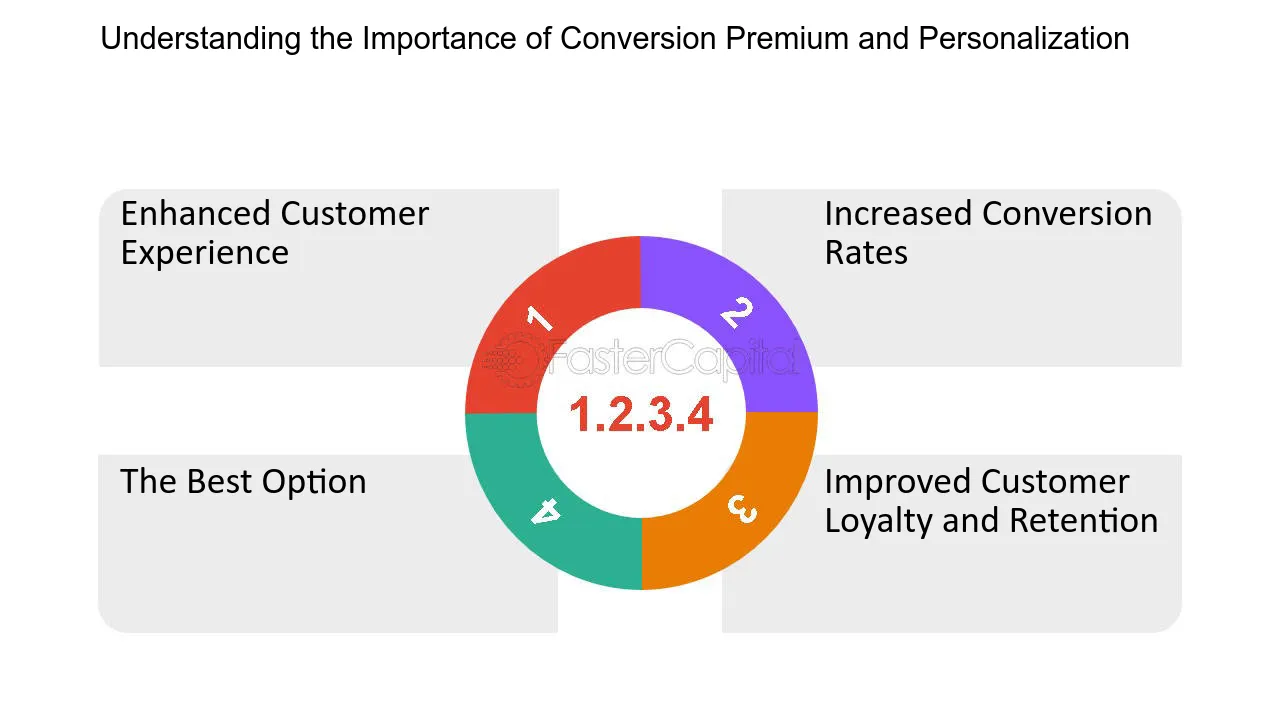
Understanding the Importance of Conversion Premium and Personalization - Conversion Premium and Personalization: Tailoring the Experience
7. Understanding the Importance of Conversion Premium in B2B Marketing
Understanding the Importance of conversion Premium in B2B marketing:
In B2B marketing, the ultimate goal is to convert leads into customers. However, simply generating leads is not enough. It is equally important to focus on conversion premium, which refers to the added value or benefit that a customer receives when they choose your product or service over your competitors. This concept is crucial in B2B marketing as it helps businesses differentiate themselves and build a competitive advantage in the market.
From the perspective of the customer, conversion premium plays a significant role in their decision-making process. When evaluating different options, customers look for the unique value proposition that sets a particular product or service apart from the rest. They want to ensure that they are getting the best possible return on their investment. Therefore, understanding and effectively communicating the conversion premium of your offering is essential to attract and retain customers.
From the business's point of view, conversion premium is a key driver of success. It helps businesses not only acquire new customers but also retain existing ones. By offering a higher conversion premium, businesses can create a sense of loyalty among their customers, making it less likely for them to switch to a competitor. This, in turn, leads to increased customer lifetime value and a more stable revenue stream.
To fully grasp the importance of conversion premium in B2B marketing, let's delve into some key aspects:
1. Differentiation: One of the primary reasons why conversion premium is vital is that it allows businesses to differentiate themselves from their competitors. By highlighting the unique features, benefits, or added value that your product or service offers, you can stand out in a crowded marketplace. For example, a software company may emphasize its user-friendly interface, customizable features, and excellent customer support as part of its conversion premium.
2. Competitive Advantage: Conversion premium provides businesses with a competitive edge. When customers perceive that your offering provides more value compared to alternatives, they are more likely to choose your product or service. This advantage can be sustained by continuously innovating and enhancing your offering to maintain a higher conversion premium than your competitors.
3. Customer Satisfaction: A higher conversion premium leads to increased customer satisfaction. When customers feel that they are getting more value for their money, they are more likely to be satisfied with their purchase decision. This satisfaction can result in positive word-of-mouth referrals and repeat business, further enhancing the reputation and credibility of your brand.
4. Pricing Strategy: Conversion premium also influences the pricing strategy of a business. When a product or service offers a higher conversion premium, businesses can justify a premium price. Customers are often willing to pay more for a superior offering that meets their needs effectively. However, it is crucial to strike the right balance between pricing and perceived value to avoid pricing yourself out of the market.
5. Continuous Improvement: To maintain a high conversion premium, businesses must continuously strive to improve their offering. By analyzing customer feedback, monitoring market trends, and staying ahead of competitors, businesses can identify areas for improvement and implement necessary changes. This commitment to continuous improvement ensures that the conversion premium remains relevant and compelling to customers.
Considering these aspects, it is clear that understanding and leveraging conversion premium is crucial for B2B marketers. By effectively communicating the unique value proposition of their offering, businesses can attract and retain customers, gain a competitive advantage, and drive long-term success in the market.
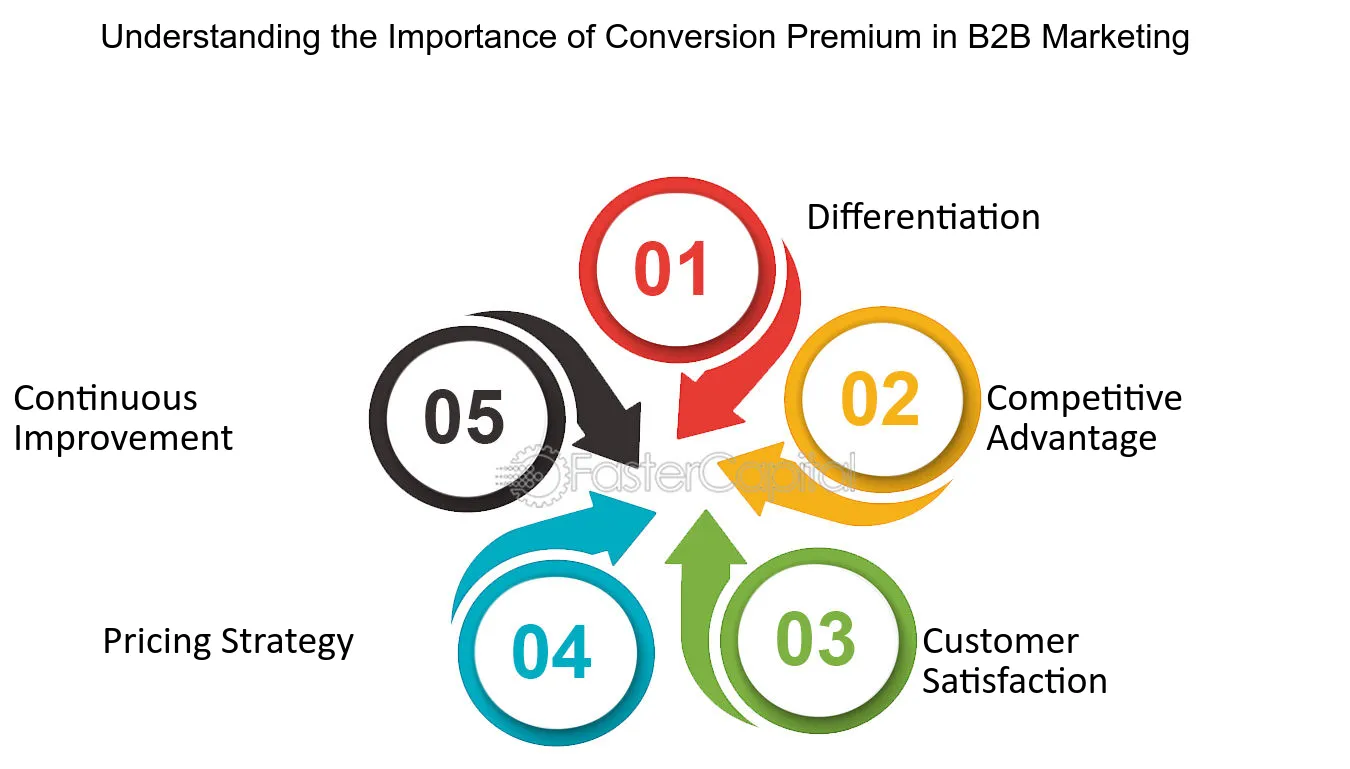
Understanding the Importance of Conversion Premium in B2B Marketing - Conversion Premium in B2B Marketing: Converting Leads to Customers
8. The Importance of Conversion Premium in the Digital Age
The digital age has revolutionized the way businesses operate, and one of the key factors that determine success in this era is conversion premium. In simple terms, conversion premium refers to the extra value or benefit that a customer receives from choosing one brand over another in the digital space. It is crucial for businesses to understand the importance of conversion premium and adapt their strategies accordingly to stay competitive in this rapidly evolving landscape.
From the customer's perspective, conversion premium is vital as it directly impacts their decision-making process. In a world where consumers have access to a plethora of options at their fingertips, they are naturally inclined to choose the brand that offers the most value. This value can come in various forms, such as superior product quality, exceptional customer service, personalized experiences, or exclusive rewards and incentives. By focusing on providing a high conversion premium, businesses can effectively capture and retain customers in an increasingly competitive market.
1. building brand loyalty: A strong conversion premium plays a significant role in building brand loyalty. When customers feel that they are getting more value from a particular brand, they are more likely to develop an emotional connection and remain loyal to it. For example, Apple has successfully created a loyal customer base by offering premium products with innovative features and exceptional user experiences. Customers are willing to pay a premium for Apple products because they perceive a higher conversion premium compared to other brands.
2. Differentiating from competitors: In a crowded digital marketplace, differentiation is key. By focusing on providing a higher conversion premium, businesses can stand out from their competitors and attract more customers. For instance, Amazon Prime offers numerous benefits to its subscribers, such as free and fast shipping, access to exclusive deals, and streaming services. These additional perks create a significant conversion premium for Amazon Prime members, setting the brand apart from other e-commerce platforms.
3. Increasing customer lifetime value: Conversion premium not only helps in acquiring new customers but also plays a crucial role in increasing customer lifetime value. When customers perceive a higher value from a brand, they are more likely to make repeat purchases and become advocates for the brand. For example, Starbucks offers a loyalty program that provides customers with exclusive rewards, personalized offers, and free drinks. This conversion premium encourages customers to visit Starbucks more frequently and spend more, thereby increasing their lifetime value to the brand.
4. enhancing customer satisfaction: Conversion premium is directly linked to customer satisfaction. When customers feel that they are receiving more value from a brand, they are more likely to be satisfied with their purchase decision. This satisfaction, in turn, leads to positive word-of-mouth, customer referrals, and ultimately, business growth. For instance, Zappos, an online shoe retailer, is known for its exceptional customer service and hassle-free return policy. These factors contribute to a high conversion premium, resulting in satisfied customers who are more likely to recommend the brand to others.
Conversion premium is of utmost importance in the digital age. It drives customer decision-making, builds brand loyalty, differentiates businesses from competitors, increases customer lifetime value, and enhances overall customer satisfaction. By understanding the significance of conversion premium and implementing strategies to deliver a higher value proposition, businesses can thrive in the ever-changing digital landscape.
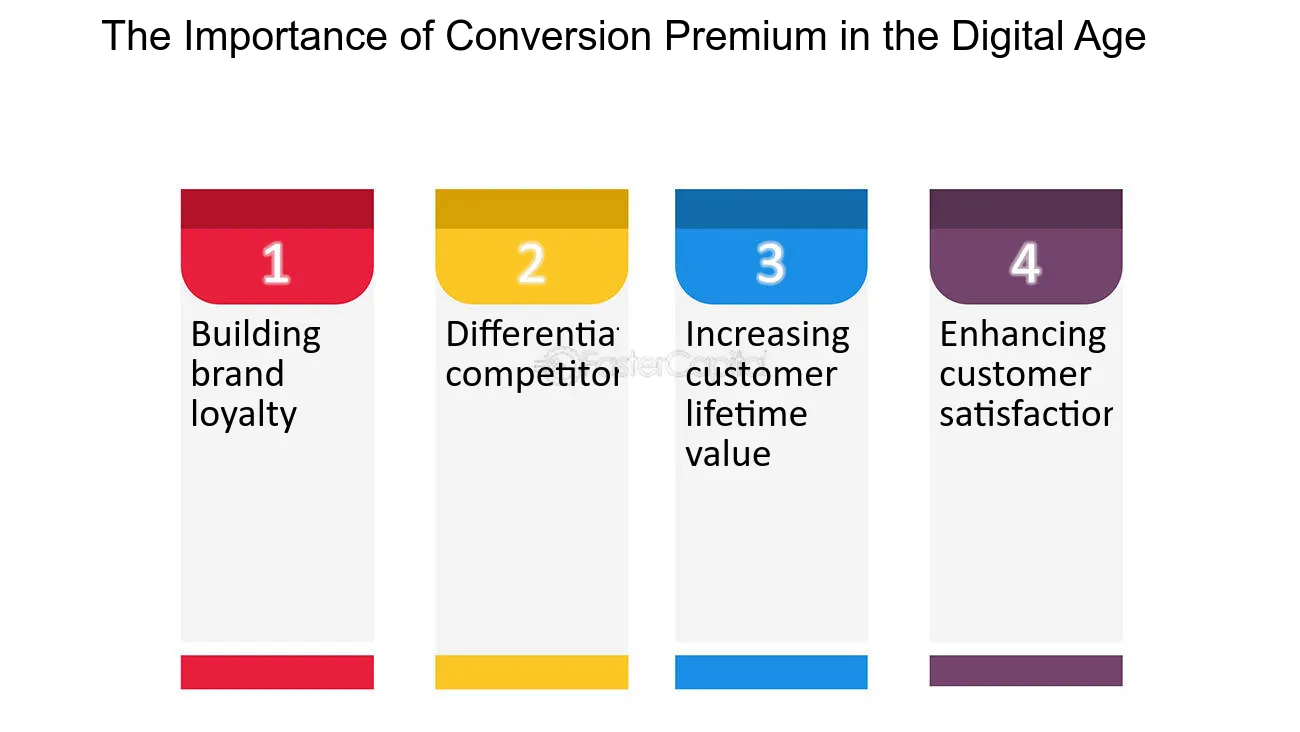
The Importance of Conversion Premium in the Digital Age - Conversion Premium in the Digital Age: Adapting to Change
9. Understanding the Importance of Conversion Premium
Understanding the Importance of Conversion Premium
In the digital age, where businesses are constantly vying for attention and striving to stay ahead of the curve, conversion premium has emerged as a crucial concept. Conversion premium refers to the value that is added to a product or service when it successfully convinces a potential customer to take a desired action, such as making a purchase or signing up for a newsletter. This value goes beyond the immediate transaction and encompasses the long-term benefits that can be derived from converting a visitor into a loyal customer.
From a business perspective, conversion premium holds immense significance. It directly impacts the bottom line, as a higher conversion rate means more revenue and increased profitability. Additionally, conversion premium contributes to brand reputation and customer loyalty, which are vital for sustained success in today's competitive marketplace. Understanding the importance of conversion premium is essential for businesses to effectively allocate their resources and optimize their marketing strategies.
1. Enhances Customer Experience: Conversion premium is closely tied to the overall customer experience. When a visitor feels engaged, valued, and compelled to take action, the conversion premium is likely to be high. By focusing on improving the user experience, businesses can create a seamless journey for their customers, reducing friction and increasing the likelihood of conversion. For example, a well-designed and intuitive e-commerce website with easy navigation and a streamlined checkout process can significantly boost conversion rates.
2. builds Trust and credibility: Conversion premium relies heavily on trust and credibility. Customers are more likely to convert when they have confidence in the product or service being offered. Testimonials, customer reviews, and social proof can play a crucial role in building trust and increasing conversion premium. For instance, an online retailer that prominently displays positive customer reviews and ratings on their website can instill confidence in potential buyers, resulting in higher conversion rates.
3. Personalization and Targeting: Personalization is a key factor in driving conversion premium. By tailoring marketing
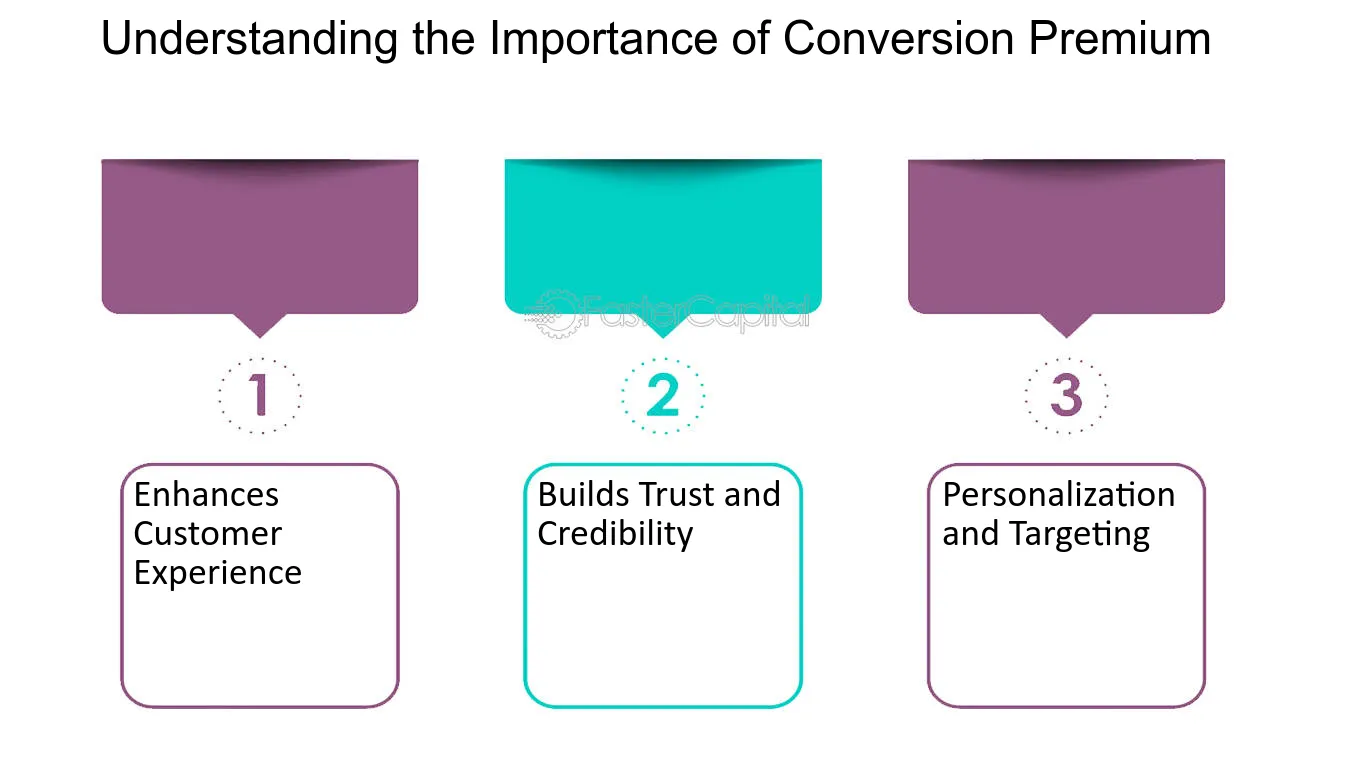
Understanding the Importance of Conversion Premium - Conversion Premium in the Digital Age: Staying Ahead of the Curve
10. Understanding the Importance of Conversion Premium Metrics
Understanding the Importance of Conversion Premium Metrics
In today's digital age, businesses rely heavily on online marketing strategies to drive traffic and generate leads. However, merely attracting visitors to your website is not enough; the ultimate goal is to convert those visitors into paying customers. This is where conversion premium metrics come into play. These metrics are crucial for measuring and analyzing the success of your conversion efforts, helping you make informed decisions to optimize your conversion rates.
From a business perspective, conversion premium metrics provide valuable insights into the effectiveness of your marketing campaigns. By tracking and analyzing these metrics, you can identify which campaigns are driving the most conversions and allocate your resources accordingly. For instance, you might find that your email marketing campaign has a higher conversion rate compared to your social media advertising. Armed with this information, you can focus more on email marketing to maximize your return on investment.
From a customer perspective, conversion premium metrics can help you understand how your website is performing in terms of user experience and engagement. For example, bounce rate is a key metric that indicates the percentage of visitors who leave your website after viewing only one page. A high bounce rate may suggest a poor user experience or irrelevant content. By analyzing this metric, you can identify areas for improvement and optimize your website to keep visitors engaged and encourage them to convert.
To gain a deeper understanding of the importance of conversion premium metrics, let's delve into some specific metrics and their significance:
1. Conversion Rate: This is perhaps the most important metric for measuring the success of your conversion efforts. It represents the percentage of visitors who take a desired action, such as making a purchase or filling out a contact form. A higher conversion rate indicates that your website and marketing strategies are effectively persuading visitors to become customers.
2. Average Order Value: This metric measures the average value of each purchase made by a customer. By analyzing this metric, you can identify opportunities to increase the average order
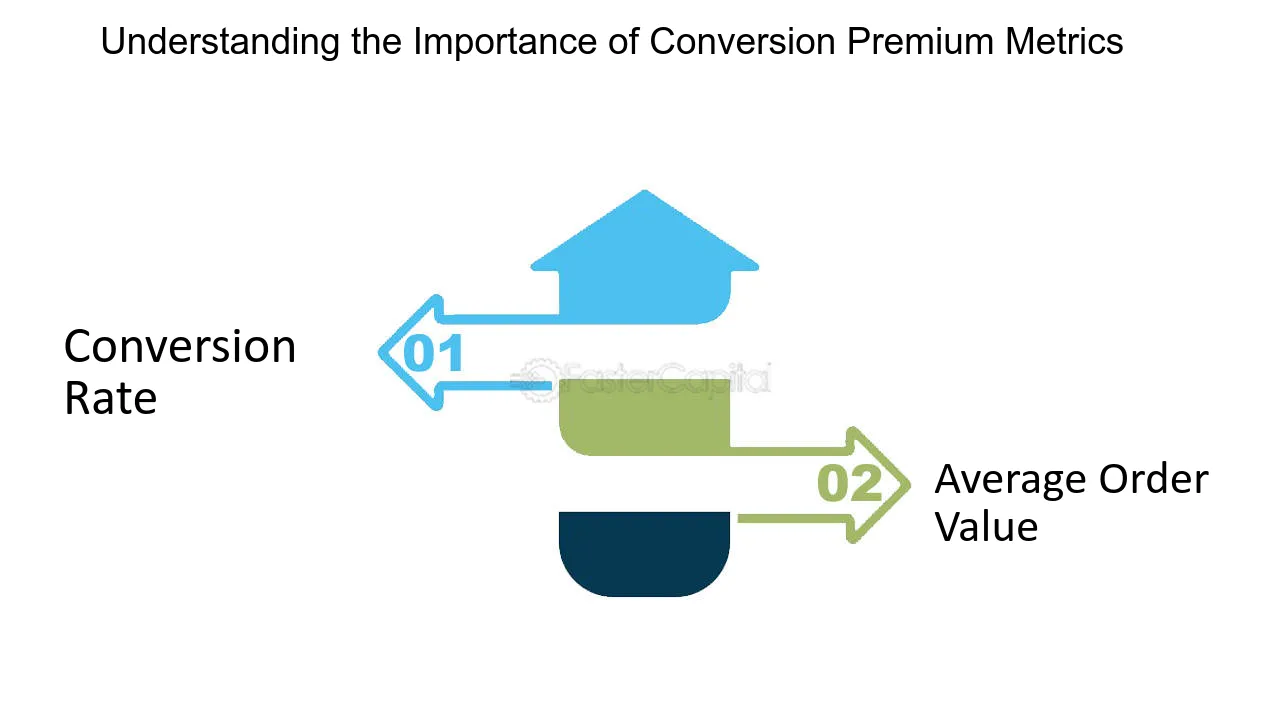
Understanding the Importance of Conversion Premium Metrics - Conversion Premium Metrics: Measuring and Analyzing Success
11. Understanding the Importance of Conversion Premium Optimization
1. Understanding Conversion Premium Optimization
Conversion Premium Optimization (CPO) is a crucial aspect of any successful online business. It involves maximizing the return on investment (ROI) by converting a higher percentage of website visitors into paying customers or subscribers. In today's competitive digital landscape, where acquiring new customers can be expensive and challenging, CPO plays a pivotal role in driving growth and profitability.
From a business perspective, CPO is essential as it directly impacts revenue and profitability. By optimizing the conversion process, businesses can generate more sales, increase average order value, and improve customer lifetime value. This ultimately leads to a higher return on marketing spend and a more sustainable business model.
From a user's perspective, CPO is equally important. Users expect a seamless and intuitive experience when interacting with a website or mobile app. If the conversion process is cumbersome, confusing, or time-consuming, users are more likely to abandon their purchase or opt-out of subscribing to a service. Therefore, optimizing the conversion process ensures a positive user experience, resulting in higher customer satisfaction and retention.
2. The Benefits of Conversion Premium Optimization
Implementing CPO strategies can yield several benefits for businesses. Here are some key advantages:
- increased conversion rates: By optimizing various elements of the conversion process, such as landing pages, checkout processes, or lead generation forms, businesses can significantly improve their conversion rates. This means more visitors will convert into customers or subscribers, resulting in higher revenue.
- improved user experience: CPO involves streamlining the user journey, reducing friction, and enhancing the overall user experience. This can result in higher customer satisfaction, increased trust in the brand, and improved customer loyalty.
- Enhanced customer insights: CPO often involves analyzing user behavior and conducting A/B tests to identify the most effective strategies. This process generates valuable insights into customer preferences, pain points, and motivations. These insights can be used to refine marketing strategies, tailor messaging, and optimize the overall customer experience.
3. CPO Strategies and Best Practices
To achieve optimal conversion rates, businesses can employ various CPO strategies and best practices. Here are some effective techniques:
- Clear and compelling calls-to-action (CTAs): CTAs are critical in guiding users towards the desired conversion action. They should be concise, action-oriented, and visually prominent. For example, instead of a generic "Submit" button, a more persuasive CTA like "Get Your Free Trial Now" can significantly increase conversions.
- Simplified forms and checkout processes: Lengthy forms or complicated checkout processes can deter users from completing their purchase. By minimizing the number of form fields, providing auto-fill options, and offering guest checkout options, businesses can streamline the conversion process and reduce friction.
- social proof and testimonials: Incorporating social proof, such as customer testimonials or positive reviews, can instill trust and credibility in potential customers. Displaying real-life success stories or showcasing endorsements from industry experts can significantly influence purchase decisions.
- Personalization and targeted messaging: Tailoring the messaging and content based on user demographics, preferences, or past behaviors can greatly enhance the relevance and effectiveness of marketing efforts. For instance, sending personalized product recommendations based on a user's browsing history can increase the likelihood of conversion.
Understanding the importance of Conversion Premium Optimization is crucial for businesses aiming to thrive in the digital landscape. By implementing effective CPO strategies and best practices, businesses can increase conversion rates, improve user experience, and ultimately drive growth and profitability.
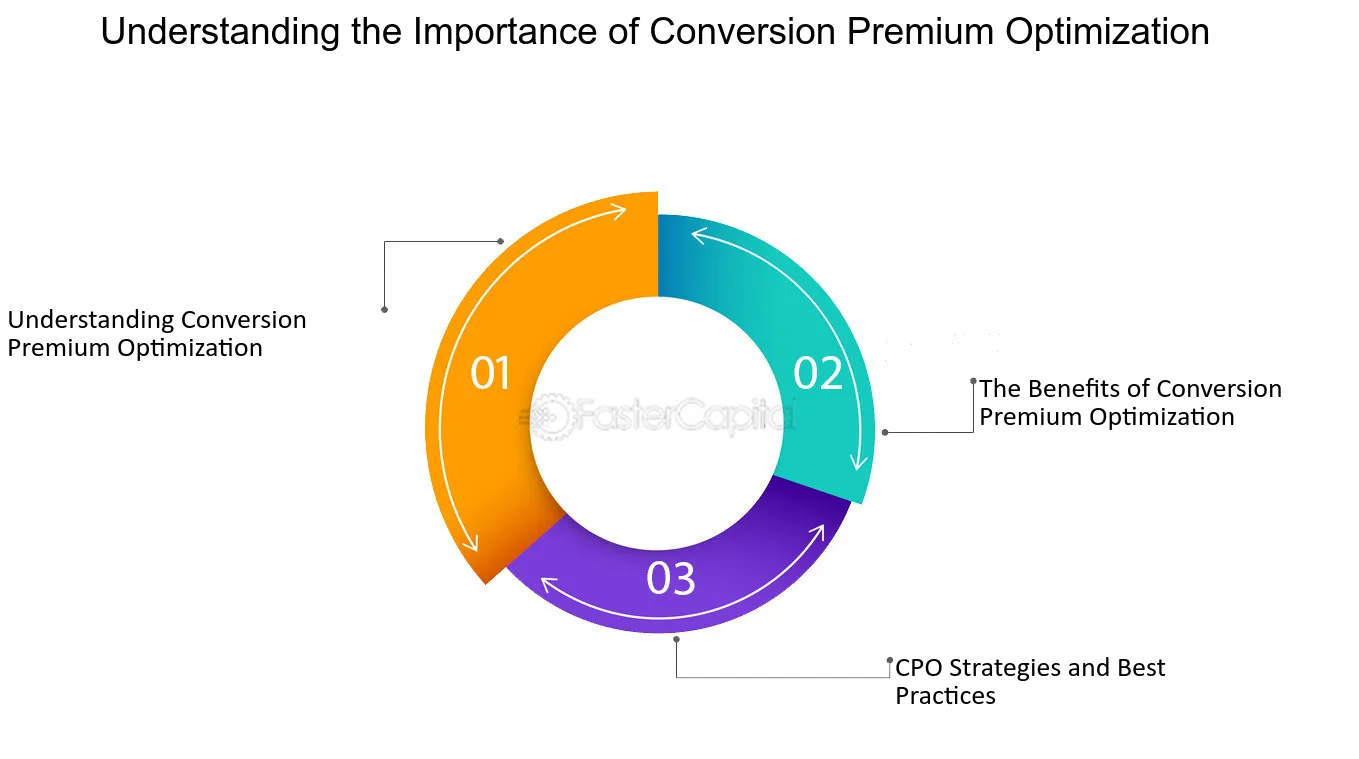
Understanding the Importance of Conversion Premium Optimization - Conversion Premium Optimization: A Step by Step Guide
12. Success Stories Highlighting the Importance of Conversion Premium
1. Case Study 1: E-commerce Website
In this case study, we will examine the success story of an e-commerce website that implemented Conversion Premium strategies to boost their sales. The website, which sells clothing and accessories, was struggling with a high bounce rate and low conversion rate. They decided to invest in Conversion Premium tactics to improve their overall performance.
- The website implemented personalized product recommendations based on user browsing history and purchase behavior. By leveraging data analytics and machine learning algorithms, they were able to deliver highly relevant recommendations to each individual user. This resulted in a significant increase in click-through rates and ultimately, conversions.
- Additionally, they optimized their checkout process by simplifying the steps and minimizing distractions. They also implemented a guest checkout option to reduce friction for first-time buyers. As a result, the website saw a decrease in cart abandonment rate and an increase in completed purchases.
- Furthermore, the website utilized social proof elements such as customer reviews and ratings to build trust and credibility. By prominently displaying positive reviews and testimonials, they were able to alleviate any doubts potential customers may have had and encourage them to make a purchase.
2. Case Study 2: Software-as-a-Service (SaaS) Company
Let's now explore a case study of a SaaS company that focused on Conversion Premium strategies to enhance their user onboarding process and increase customer retention.
- The company implemented a comprehensive onboarding email series that guided users through different features and functionalities of their software. By providing valuable content and step-by-step instructions, they ensured that users understood the value proposition and experienced early success with the product.
- They also incorporated gamification elements into their onboarding process, such as progress bars and achievement badges. This not only made the onboarding experience more engaging but also motivated users to explore more features and become power users.
- In addition, the company offered personalized support and training to new customers. They assigned dedicated customer success managers who provided one-on-one assistance and addressed any questions or concerns promptly. This personalized approach significantly reduced churn rate and increased customer satisfaction.
3. Case Study 3: Lead Generation Website
Now, let's turn our attention to a case study of a lead generation website that utilized Conversion Premium strategies to improve their lead quality and increase conversion rates.
- The website implemented a lead scoring system that assigned a value to each lead based on various factors such as demographics, behavior, and engagement level. This allowed the sales team to prioritize high-quality leads and focus their efforts on those most likely to convert into paying customers.
- They also implemented targeted landing pages for different buyer personas. By tailoring the messaging and content to specific segments, they were able to increase relevancy and capture the attention of their target audience. This resulted in higher conversion rates and improved overall lead quality.
- Furthermore, the website utilized A/B testing to optimize their lead generation forms. They experimented with different form layouts, field requirements, and call-to-action buttons to find the most effective combination. Through iterative testing and analysis, they were able to identify the best-performing form design that maximized conversions.
These case studies demonstrate the importance of Conversion Premium strategies in achieving success in various industries. Whether it's an e-commerce website, a SaaS company, or a lead generation website, implementing personalized and targeted tactics can significantly improve conversion rates, user experience, and overall business performance. By investing in Conversion Premium, businesses can differentiate themselves from competitors, build customer loyalty, and ultimately drive sustainable growth.

Success Stories Highlighting the Importance of Conversion Premium - Conversion Premium vs: Conversion Rate: Which Matters More
13. The Importance of Conversion Premium in Driving Sales and Revenue
The Role of Conversion Premium in E-commerce Success
In the competitive world of e-commerce, driving sales and revenue is the ultimate goal for businesses. One key strategy that has proven to be effective in achieving this goal is the implementation of conversion premium. Conversion premium refers to the extra value that a customer perceives in a product or service, which prompts them to make a purchase. It is an essential factor in driving sales and revenue, as it not only increases the likelihood of conversion but also encourages customers to spend more.
1. building Trust and credibility:
Conversion premium plays a crucial role in building trust and credibility with customers. When customers perceive a product or service to have higher value, they are more likely to trust the brand and make a purchase. For example, offering a premium version of a product with additional features or benefits can instill confidence in customers and make them more willing to invest in the higher-priced option. By emphasizing the value and quality of the product, businesses can effectively build trust and credibility, ultimately driving sales and revenue.
2. Differentiating from Competitors:
In today's saturated e-commerce market, standing out from competitors is essential. Conversion premium provides a unique opportunity to differentiate a product or service from others in the market. By offering something extra or exclusive, businesses can create a competitive advantage that attracts customers. For instance, a clothing brand may offer limited edition designs or personalized customization options, which can entice customers to choose their product over competitors'. This differentiation not only drives sales but also allows businesses to command higher prices, thereby increasing revenue.
3. upselling and Cross-selling Opportunities:
Conversion premium opens doors for upselling and cross-selling opportunities, further driving sales and revenue. When customers perceive a product to have higher value, they are more likely to consider additional purchases or upgrades. For example, a software company may offer a basic version of their product at a lower price point, but also provide premium features and functionalities in a higher-priced package. By showcasing the value of the premium option and highlighting how it enhances the customer's experience, businesses can encourage customers to opt for the more expensive package, resulting in increased revenue.
4. enhancing Customer experience:
A positive customer experience is crucial for driving sales and revenue in e-commerce. Conversion premium can greatly contribute to enhancing the overall customer experience. By offering additional benefits or services, businesses can exceed customer expectations and leave a lasting impression. For instance, an online retailer may provide free shipping, exclusive discounts, or personalized customer support to customers who opt for the premium version of a product. These added perks not only increase the perceived value of the product but also create a positive association with the brand, leading to customer loyalty and repeat purchases.
5. The Best Option: Balancing Value and Affordability:
While conversion premium is essential for driving sales and revenue, it is crucial to strike a balance between value and affordability. Customers should perceive the extra value offered by the premium option to be worth the additional cost. conducting market research, understanding customer preferences, and analyzing competitors' offerings can help businesses determine the right balance. It is important to ensure that the premium option provides tangible benefits that align with customer needs and preferences, without pricing it out of reach for the target market. By finding this sweet spot, businesses can maximize the impact of conversion premium on sales and revenue.
Conversion premium plays a vital role in driving sales and revenue in the e-commerce landscape. By building trust, differentiating from competitors, creating upselling opportunities, enhancing customer experience, and finding the right balance between value and affordability, businesses can effectively leverage conversion premium to achieve their goals. It is an indispensable strategy for e-commerce success, enabling businesses to not only increase conversion rates but also boost revenue and establish a strong brand presence in the market.
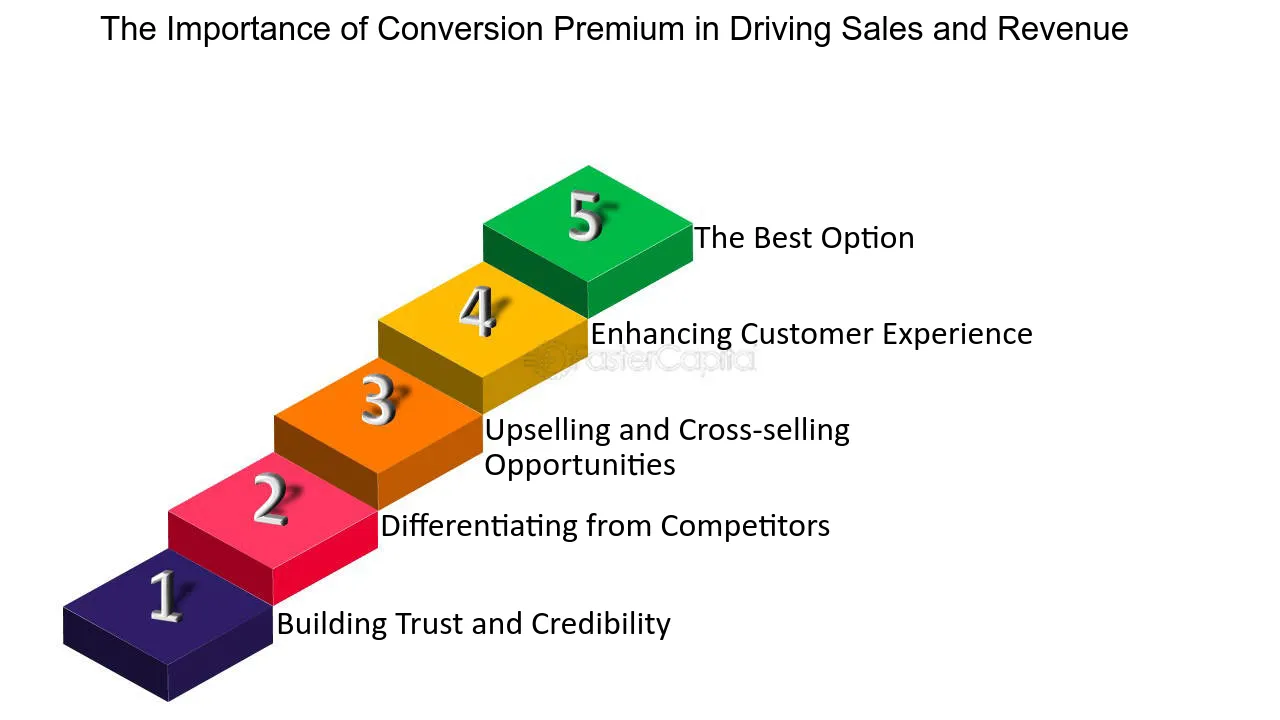
The Importance of Conversion Premium in Driving Sales and Revenue - The Role of Conversion Premium in E commerce Success